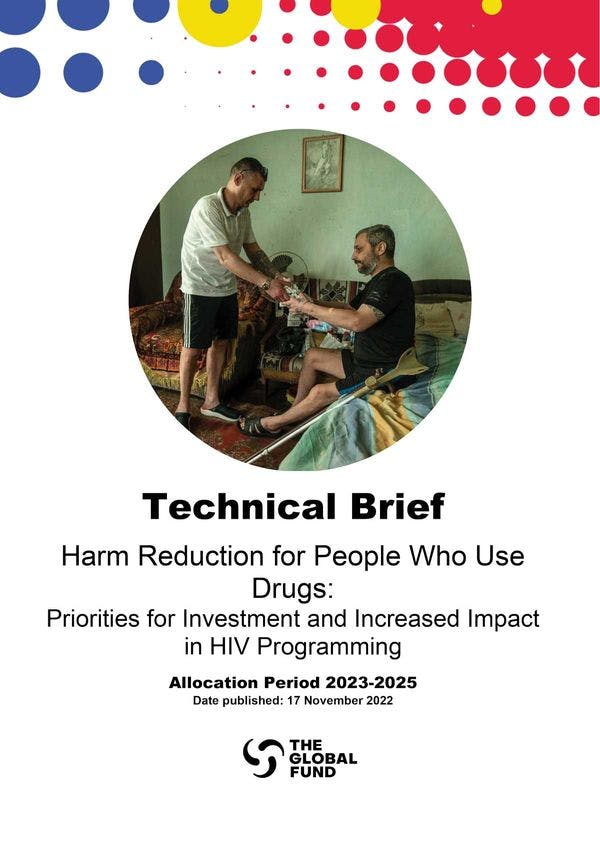Reducción de daños para personas que consumen drogas: Prioridades de inversión y mayor impacto sobre programación referida a VIH del Fondo Mundial (2023-2025)
El Fondo Mundial presenta una guía para que los solicitantes planifiquen y amplíen programas efectivos contra el VIH y el VHC para personas que consumen drogas, especialmente quienes se inyectan estas sustancias. Más información, en inglés, está disponible abajo.
For people who inject drugs, harm reduction is critically important to reduce the risk of infection with HIV or viral hepatitis and to improve prevention, diagnosis and treatment. People who use opioids or amphetamines by snorting, smoking or taking them orally can also be at increased risk of HIV when combining drug use and sex. “Harm reduction” refers to policies, programs and practices that minimize negative health, social and legal impacts of drug use and drug laws and policies. Harm reduction approaches focus on supporting positive change without requiring that people stop using drugs.
This brief is meant to help applicants to the Global Fund plan for and scale up effective HIV and hepatitis C programming for people who use drugs, particularly those who inject. Applicants should consult the Global Fund HIV Information Note and Modular Framework Handbook, which detail the full range of biomedical, behavioral and structural interventions that the Global Fund supports as part of a comprehensive HIV response. This brief, drawing on review of past programming and guidance from UN partners, highlights specific lessons and recommendations for harm reduction programming. Closing the HIV prevention gap for key populations, including people who inject drugs, is a priority in the Global Fund’s 2023-2028 strategy. Removing human rights-related barriers to services, and ensuring that community leadership is at the heart of the HIV response, are also strategic priorities.
The Global Fund considers harm reduction a “program essential” — that is, a critical part of a country’s comprehensive HIV response. Countries are requested to address the status of and progress toward achieving program essentials in their applications for Global Fund support, and Core and High-Impact countries are required to include plans to scale up those not yet fully implemented in their funding narrative. The Global Fund requires upper-middle-income countries to focus 100% of their country grant budget on maintaining or scaling up services to key populations, including people who inject drugs, and asks all countries to prioritize evidence-based, rights-respecting, highest-impact interventions. Evidence shows that harm reduction is high-impact (and cost-effective) HIV prevention for people who inject drugs in countries of all income levels.
Some countries report that they do not have a full enough picture of drug use to begin services for people who use drugs, or that they have not made the necessary changes in laws in order to start harm reduction. Others decline to collect current information on drug use and HIV risk, or keep harm-reduction programs small for years (”perpetual pilot”). Injecting drugs with non-sterile equipment spreads HIV, hepatitis C (HCV) and other bloodborne diseases quickly, so it is very important not to wait before starting or scaling up programming. While good data about drug use and police agreement not to interfere with harm reduction services are both important, countries do not need to wait for perfect information or for Parliament to pass new laws to begin programming. This brief includes information about steps that countries can take at different stages in their harm reduction programming: whether starting, increasing the numbers of people reached, or maintaining a program at scale.
HIV risk comes not just from non-sterile injecting equipment, but from policies, practices, and attitudes that keep people who use drugs from accessing services. Police harassment, for example, has been shown to increase the likelihood of needle sharing and to discourage people who use drugs from accessing harm reduction services or other healthcare.2 Failure to meaningfully engage people who use drugs in creating, delivering and evaluating harm reduction services can result in programs that fail to meet the needs of the people they are meant to serve.
The Global Fund evaluates proposals for plans to deliver services to people who use drugs and on how countries plan to remove human rights-related barriers to those services. It also evaluates whether proposals recognize the leadership of people who use drugs in strengthening services, increasing health system accountability and addressing structural barriers. Integrating these approaches is essential to increase the impact of HIV prevention programs.
The Global AIDS strategy calls on countries to sharply scale up harm reduction to ensure that 90% of people who inject drugs have access to harm reduction services (see Box 1). The Global AIDS strategy, the Global Fund strategy, and the 2021 Political Declaration on HIV and AIDS endorsed by the UN General Assembly all emphasize the need to change laws and policies so that HIV services can be effectively delivered. This brief helps countries receiving funding from the Global Fund to move toward that goal.
